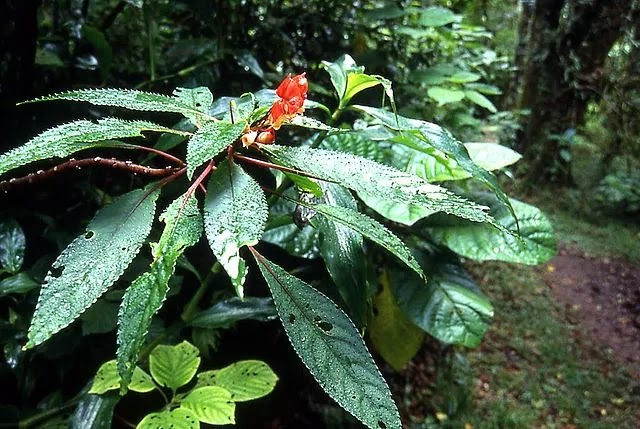
This beautiful site, Amber Mountain, is in the Diana Region of northern Madagascar. It is famous among the people for its waterfalls and crater lakes. It is 1,000 km (620 mi) north of the capital Antananarivo.

It is one of the most biologically diverse places in the African state of Madagascar. It has seventy-five bird species, twenty-five mammal species, and fifty-nine reptile species.
More Information About Amber Mountain
The park covers an area of 18,200 ha (45,000 acres) on an isolated volcanic massif, mostly basaltic rock. Attractions include spectacular waterfalls, crater lakes, rivers, and streams.
The park is a water catchment area for the town of Antsiranana. Semi-desert and dry, sparse forests with succulent plants surround this town.
The annual rainfall in this area is 3,585 mm (141.1 in), compared with 1,000 mm (39 in) around the Antsiranana. The authority named the area after the deposits of copal, a soft form of amber.
This site is one of the most accessible places in northern Madagascar. Bush taxis travel to Joffreville from Antsiranana, taking about 45 minutes.
You will see a few small villages on the trip up the mountain to the entrance. In Joffreville, there is a good lodge available for guests.
The people of the Sakavala and Antankarana communities live in and around the site. Montane rainforest covers most of the area of this site.
The trees are up to 40 m tall and covered in lianas, orchids, and ferns. The surrounding dry forests isolate the forest from other rainforests.
Plantations of Eucalyptus and exotic conifers are also available. These include pines, Araucaria, and an invasive alien bush, Lantana camara.
The authority has recorded over one thousand species of plants. The park has twenty-five species of mammals. Eight species of lemur are only visible in the park.
The park is also home to the ring-tailed mongoose (Galidia elegans) and the Malagasy civet. Of the 75 bird species here, 35 are visible only in this park.
For example, the Amber rock thrush is only famous for one area on the Amber massif. This park is also mentionable for its amphibians and reptiles.
For example, the Amber leaf chameleon lives there. This chameleon is one of the smallest reptiles in the world. There are 35 frog species in the park.
Things to Do
It is the best site for embarking on a self-guided foot safari. You will not spot anything like it in the other Big Five sites in Africa.
However, this site will reward you with plenty of lemur species. You will also see reptiles, mongooses, and butterflies.
Hike on one of the plentiful trails to discover cascading waterfalls and varied plant life. You can also find high-altitude crater lakes.
Mountain climbers can get adventure by taking a multi-day backpacking trek. You can camp at two designated campgrounds within the park.
You can also backcountry camp along trails at primitive sites. Be sure to pack all your needs, like a backpack, tent, sleeping bag, food, and water, as few services exist in this park.
Visitors can also stay in the neighboring town of Joffreville. It is 3 kilometers, or 1.8 miles, from the entrance of this site. This French Colonial village offers period-dated architecture and a laid-back vibe.
This authentic town has several restaurants and lodging options. They will allow you to immerse yourself in the Malagasy culture.
Wildlife Viewing
This site contains three different types of magnificent ecosystems. These ecosystems are montane rainforest, mid-altitude rainforest, and dry deciduous forest.
This range of habitats makes this spot one of the most biologically diverse places in this country. Twenty-five notable mammal species make their home here.
These species include the endemic ring-tailed mongoose. The Malagasy civet is also present. Additionally, there are eight different species of lemur.
The park is a haven for reptile species. It houses 59 types of frogs, snakes, geckos, and chameleons. You can keep an eye out for the endemic Amber Mountain leaf chameleon.
It is one of the smallest reptiles that live on earth. This beautiful place of Madagascar has 75 bird species. Thirty-five are endemic, including the long-billed bernieria and the pitta-like ground roller.
The lovers of birds visit for the chance to spot the endangered Amber Mountain rock thrush. This bird is a local species only to some specific area of the Amber Mountain massif.
Places to Camp
You can sleep inside the park if you plan to stay longer than a day. There are two campsites, Campement Anilotra and Campement d’Andrafiabe.
Both have basic facilities, including toilets, picnic tables, and running cold water. Electricity is absent here, and the sites are very rustic.
However, the beautiful setting makes up for the lack of creature comforts. The low nightly rates help, too.
Staying inside the park can give you a chance to see nocturnal animals. You may even see the tiny majestic brown mouse lemur.
Remember to buy supplies before entering Amber Mountain. You must not forget to get firewood and food. There are no camp stores inside this fantastic park.
How to Get There
Fly internationally into the capital city of Madagascar, Antananarivo. Then, travel by air to the fantastic Amber Mountain National Park.
You can book a flight to Antsiranana on the domestic airline Tsaradia. Tsaradia offers daily direct flights that take about two hours.
The majority of the visitors then travel from Antsiranana to Joffreville. Antsiranana is the gateway to this magnificent national park.
The people who visit use a private off-road vehicle or mini-bus. Visitors can pay park entry fees, pick up trail maps, and hire local guides at the park office.
- Mantasoa: A Beautiful Municipality In Madagascar
- Lake Itasy: A Beautiful Site To Explore
- Lake Anosy: An Amazing Area In Madagascar

A Bangladeshi entrepreneur. A person who loves nature, a web developer, and the founder of Srigal and Nehrin.